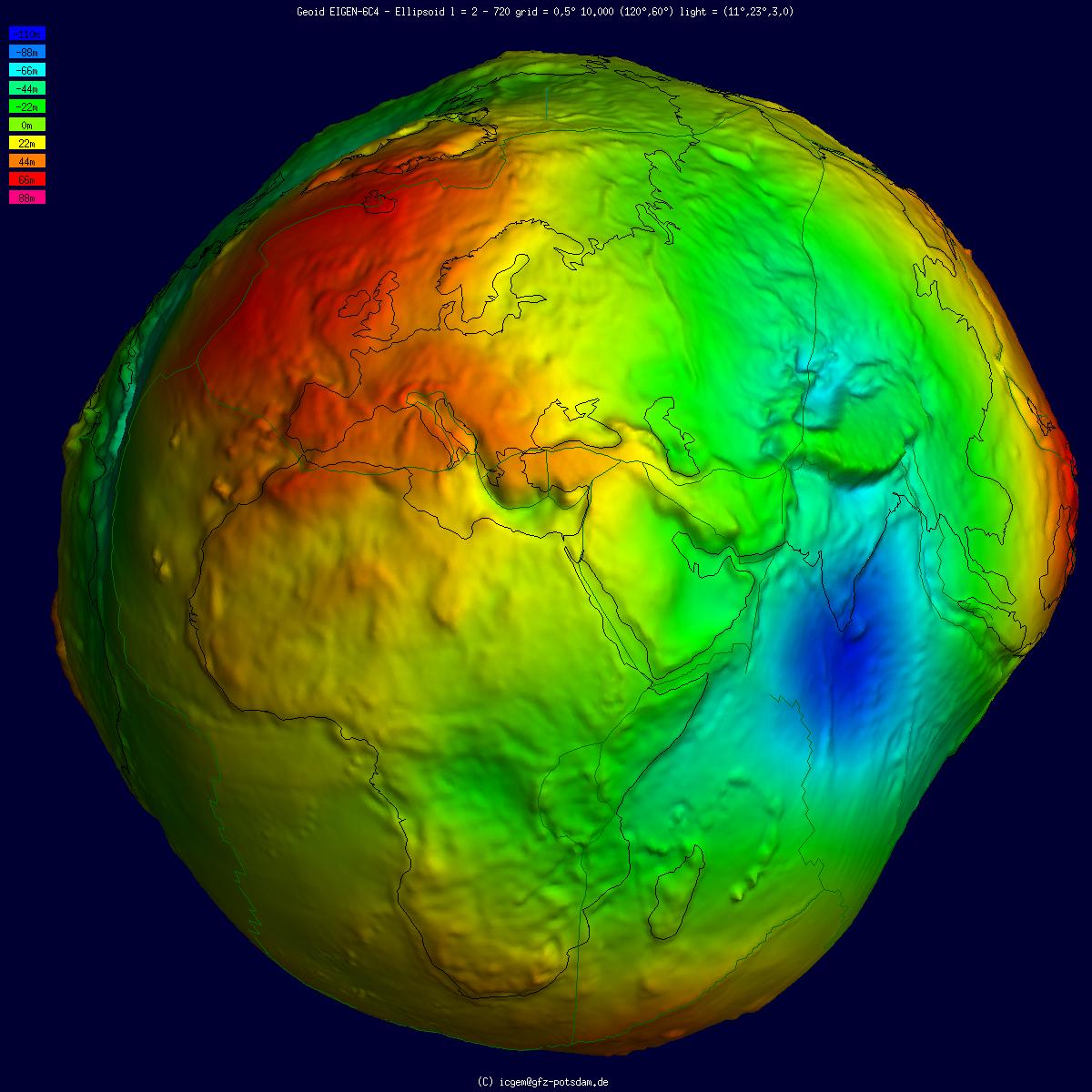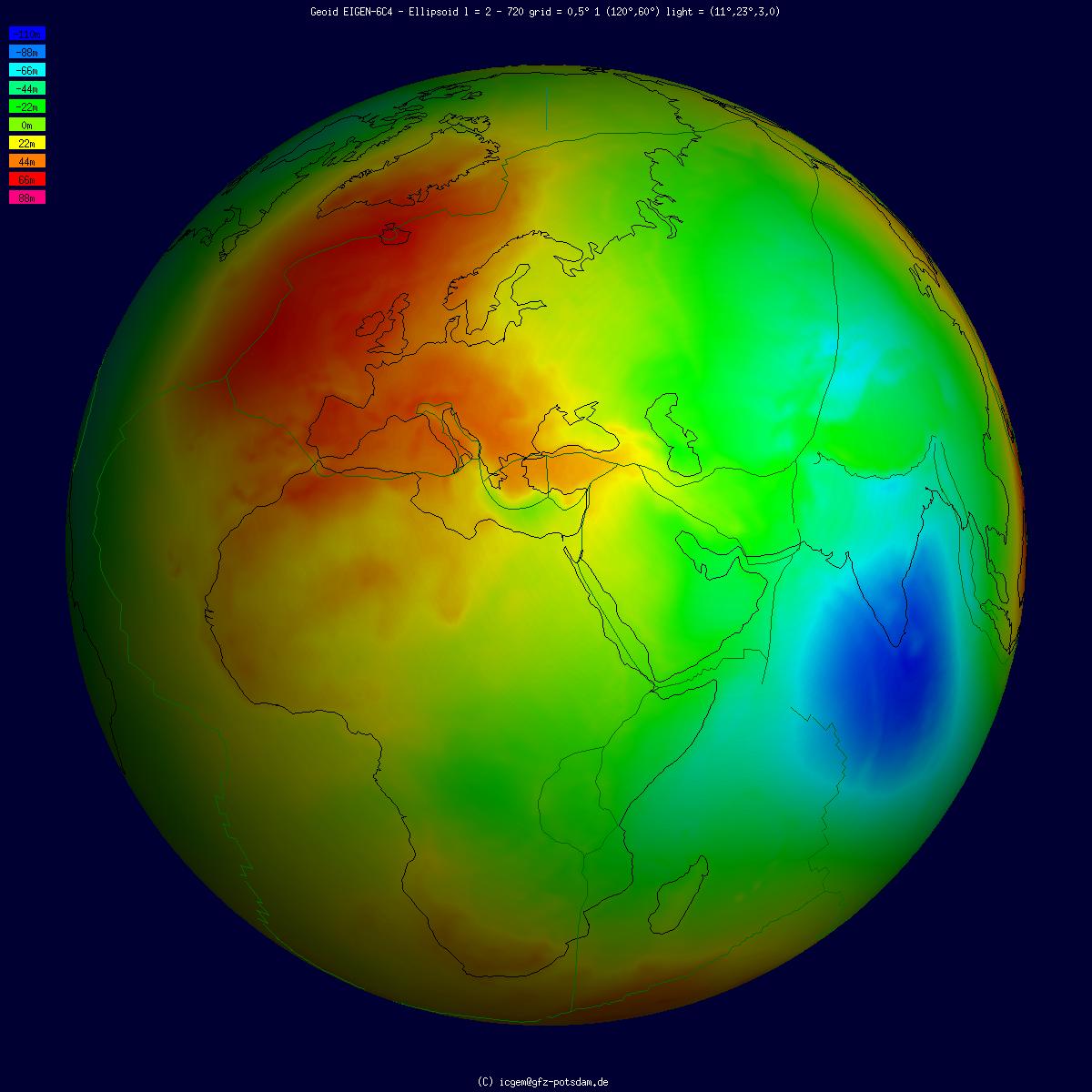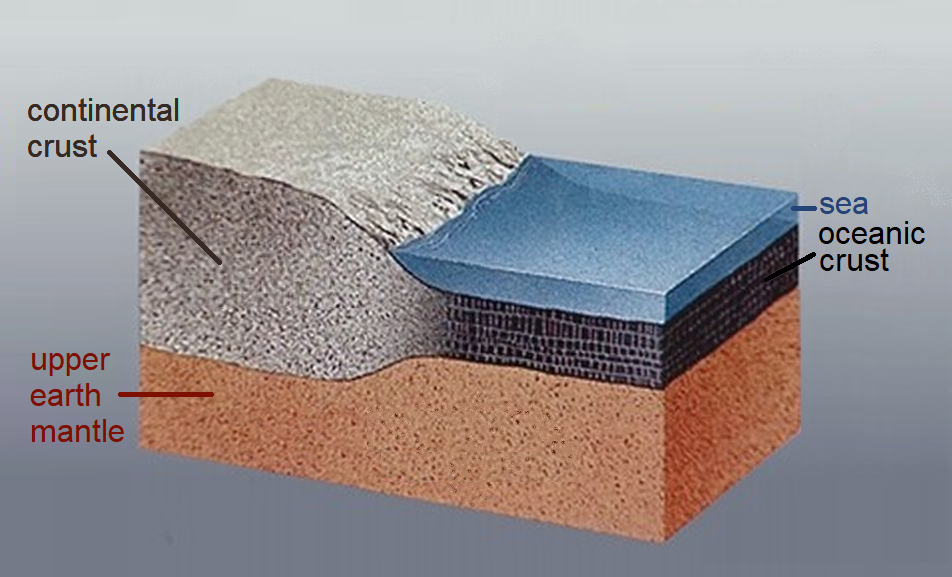|
Normal Height
Normal heights (symbol H^* or H^N; SI unit metre, m) is a type of height above sea level introduced by the Soviet scientist Mikhail Molodenskii. The normal height of a point is defined as the quotient of a point's geopotential number ''C'' (i.e. its geopotential difference with that of sea level), by the vertically averaged normal gravity: :H^N=C/\bar\gamma The average is evaluated along the normal potential's plumb line (a curve, approximated by the ellipsoidal normal, a straight line). The evaluation ranges from the Earth ellipsoid up to the point of interest; the procedure is thus recursive. Normal heights are slightly dependent upon the reference ellipsoid chosen. Normal gravity values are easier to compute compared to actual gravity, as one does not have to know the Continental crust#Density, Earth's crust density. This is an advantage of normal heights compared to orthometric heights. The reference surface where normal heights are zero is called the quasi-geoid (or quasigeoid ... [...More Info...] [...Related Items...] OR: [Wikipedia] [Google] [Baidu] |
SI Unit
The International System of Units, internationally known by the abbreviation SI (from French ), is the modern form of the metric system and the world's most widely used system of units of measurement, system of measurement. It is the only system of measurement with official status in nearly every country in the world, employed in science, technology, industry, and everyday commerce. The SI system is coordinated by the International Bureau of Weights and Measures, which is abbreviated BIPM from . The SI comprises a coherence (units of measurement), coherent system of unit of measurement, units of measurement starting with seven SI base unit, base units, which are the second (symbol s, the unit of time), metre (m, length), kilogram (kg, mass), ampere (A, electric current), kelvin (K, thermodynamic temperature), mole (unit), mole (mol, amount of substance), and candela (cd, luminous intensity). The system can accommodate coherent units for an unlimited number of additional quantiti ... [...More Info...] [...Related Items...] OR: [Wikipedia] [Google] [Baidu] |
Orthometric Height
The orthometric height (symbol ''H'') is the vertical distance along the plumb line from a point of interest to a reference surface known as the ''geoid'', the vertical datum that approximates mean sea level. Orthometric height is one of the scientific formalizations of a layman's " height above sea level", along with other types of heights in Geodesy. In the US, the current NAVD88 datum is tied to a defined elevation at one point rather than to any location's exact mean sea level. Orthometric heights are usually used in the US for engineering work, although dynamic height may be chosen for large-scale hydrological purposes. Heights for measured points are shown on National Geodetic Survey data sheets, data that was gathered over many decades by precise spirit leveling over thousands of miles. Alternatives to orthometric height include dynamic height and normal height, and various countries may choose to operate with those definitions instead of orthometric. They may also ad ... [...More Info...] [...Related Items...] OR: [Wikipedia] [Google] [Baidu] |
Physical Geodesy
Physical geodesy is the study of the physical properties of Earth's gravity and its potential field (the geopotential), with a view to their application in geodesy. Measurement procedure Traditional geodetic instruments such as theodolites rely on the gravity field for orienting their vertical axis along the local plumb line or local vertical direction with the aid of a spirit level. After that, vertical angles (zenith angles or, alternatively, elevation angles) are obtained with respect to this local vertical, and horizontal angles in the plane of the local horizon, perpendicular to the vertical. Levelling instruments again are used to obtain geopotential differences between points on the Earth's surface. These can then be expressed as "height" differences by conversion to metric units. Units Gravity is commonly measured in units of m·s−2 (metres per second squared). This also can be expressed (multiplying by the gravitational constant G in order to change units) as newto ... [...More Info...] [...Related Items...] OR: [Wikipedia] [Google] [Baidu] |
Dynamic Height
Dynamic height (symbol H^\text or H^\text) is a way of specifying the vertical position of a point above a vertical datum; it is an alternative for orthometric height or normal height. It can be computed (in SI units of metre) by dividing the location's geopotential number (symbol ''C'', in square metre per square second) by the normal gravity (symbol , in metres per square second) at 45 degree latitude and zero height, a constant value (9.806199203 m/s2): :H^\text=C/g_c Dynamic heights are usually chosen so that zero corresponds to the geoid. As dynamic height is proportional to the geopotential, it remains constant over a given equigeopotential surface. Therefore, dynamic height is the most appropriate height measure when working with the level of water (as in hydrology or oceanography) over a large geographic area. For example, it is used by the International Great Lakes Datum, across the US and Canada. However, because of variations in Earth's gravity The gravity of ... [...More Info...] [...Related Items...] OR: [Wikipedia] [Google] [Baidu] |
Geodetic Levelling
Levelling or leveling (American English; see spelling differences) is a branch of surveying, the object of which is to establish or verify or measure the height of specified points relative to a datum. It is widely used in geodesy and cartography to measure vertical position with respect to a vertical datum, and in construction to measure height differences of construction artifacts. In photolithography, the same term is used in a lithography machine calibration step measuring or calibrating wafer surface height with respect to a reference. Optical levelling Optical levelling, also known as spirit levelling and differential levelling, employs an ''optical level'', which consists of a precision telescope with crosshairs and stadia marks. The cross hairs are used to establish the level point on the target, and the stadia allow range-finding; stadia are usually at ratios of 100:1, in which case one metre between the stadia marks on the ''level staff'' (or ''rod'') represents 100 ... [...More Info...] [...Related Items...] OR: [Wikipedia] [Google] [Baidu] |
Height System
In geodesy, surveying, hydrography and navigation, vertical datum or altimetric datum is a reference coordinate surface used for vertical positions, such as the elevations of Earth-bound features (terrain, bathymetry, water level, and built structures) and altitudes of satellite orbits and in aviation. In planetary science, vertical datums are also known as zero-elevation surface or zero-level reference. Commonly adopted criteria for a vertical datum include the following approaches: * Tides, based on sea level when specific conditions occur, such as NOAA's National Geodetic Survey-produced tidal datums; * Gravimetric, based on a geoid; or geometric, based on the same Earth ellipsoids that are used in computing a horizontal datum, such as NOAA's planned gravimetric and Global Navigation Satellite Systems (GNSS)-based Datum of 2022 set to be released that year by the National Geodetic Survey. In the United States, prominent vertical datums for professional uses include the Na ... [...More Info...] [...Related Items...] OR: [Wikipedia] [Google] [Baidu] |
Himalayas
The Himalayas, or Himalaya ( ), is a mountain range in Asia, separating the plains of the Indian subcontinent from the Tibetan Plateau. The range has some of the Earth's highest peaks, including the highest, Mount Everest. More than list of highest mountains on Earth, 100 peaks exceeding elevations of above sea level lie in the Himalayas. The Himalayas abut on or cross territories of Himalayan states, six countries: Nepal, China, Pakistan, Bhutan, India and Afghanistan. The sovereignty of the range in the Kashmir region is disputed among India, Pakistan, and China. The Himalayan range is bordered on the northwest by the Karakoram and Hindu Kush ranges, on the north by the Tibetan Plateau, and on the south by the Indo-Gangetic Plain. Some of the world's major rivers, the Indus River, Indus, the Ganges river, Ganges, and the Yarlung Tsangpo River, Tsangpo–Brahmaputra River, Brahmaputra, rise in the vicinity of the Himalayas, and their combined drainage basin is home to some 6 ... [...More Info...] [...Related Items...] OR: [Wikipedia] [Google] [Baidu] |
Geoid Undulation
The geoid ( ) is the shape that the ocean surface would take under the influence of the gravity of Earth, including gravitational attraction and Earth's rotation, if other influences such as winds and tides were absent. This surface is extended through the continents (such as might be approximated with very narrow hypothetical canals). According to Carl Friedrich Gauss, who first described it, it is the "mathematical figure of the Earth", a smooth but irregular surface whose shape results from the uneven distribution of mass within and on the surface of Earth. It can be known only through extensive gravitational measurements and calculations. Despite being an important concept for almost 200 years in the history of geodesy and geophysics, it has been defined to high precision only since advances in satellite geodesy in the late 20th century. The geoid is often expressed as a geoid undulation or geoidal height above a given reference ellipsoid, which is a slightly flattened sp ... [...More Info...] [...Related Items...] OR: [Wikipedia] [Google] [Baidu] |
Equipotential Surface
In mathematics and physics, an equipotential or isopotential refers to a region in space where every point is at the same potential. This usually refers to a scalar potential (in that case it is a level set of the potential), although it can also be applied to vector potentials. An equipotential of a scalar potential function in -dimensional space is typically an ()-dimensional space. The del operator illustrates the relationship between a vector field and its associated scalar potential field. An equipotential region might be referred as being 'of equipotential' or simply be called 'an equipotential'. An equipotential region of a scalar potential in three-dimensional space is often an equipotential surface (or ''potential isosurface''), but it can also be a three-dimensional mathematical solid in space. The gradient of the scalar potential (and hence also its opposite, as in the case of a vector field with an associated potential field) is everywhere perpendicular to the equi ... [...More Info...] [...Related Items...] OR: [Wikipedia] [Google] [Baidu] |
Geoid
The geoid ( ) is the shape that the ocean surface would take under the influence of the gravity of Earth, including gravitational attraction and Earth's rotation, if other influences such as winds and tides were absent. This surface is extended through the continents (such as might be approximated with very narrow hypothetical canals). According to Carl Friedrich Gauss, who first described it, it is the "mathematical figure of the Earth", a smooth but irregular surface whose shape results from the uneven distribution of mass within and on the surface of Earth. It can be known only through extensive gravitational measurements and calculations. Despite being an important concept for almost 200 years in the history of geodesy and geophysics, it has been defined to high precision only since advances in satellite geodesy in the late 20th century. The geoid is often expressed as a geoid undulation or geoidal height above a given reference ellipsoid, which is a slightly flattene ... [...More Info...] [...Related Items...] OR: [Wikipedia] [Google] [Baidu] |
Mean Sea Level
A mean is a quantity representing the "center" of a collection of numbers and is intermediate to the extreme values of the set of numbers. There are several kinds of means (or "measures of central tendency") in mathematics, especially in statistics. Each attempts to summarize or typify a given group of data, illustrating the magnitude and sign of the data set. Which of these measures is most illuminating depends on what is being measured, and on context and purpose. The ''arithmetic mean'', also known as "arithmetic average", is the sum of the values divided by the number of values. The arithmetic mean of a set of numbers ''x''1, ''x''2, ..., x''n'' is typically denoted using an overhead bar, \bar. If the numbers are from observing a sample of a larger group, the arithmetic mean is termed the '' sample mean'' (\bar) to distinguish it from the group mean (or expected value) of the underlying distribution, denoted \mu or \mu_x. Outside probability and statistics, a wide rang ... [...More Info...] [...Related Items...] OR: [Wikipedia] [Google] [Baidu] |
Continental Crust
Continental crust is the layer of igneous, metamorphic, and sedimentary rocks that forms the geological continents and the areas of shallow seabed close to their shores, known as '' continental shelves''. This layer is sometimes called '' sial'' because its bulk composition is richer in aluminium silicates (Al-Si) and has a lower density compared to the oceanic crust, called '' sima'' which is richer in magnesium silicate (Mg-Si) minerals. Changes in seismic wave velocities have shown that at a certain depth (the Conrad discontinuity), there is a reasonably sharp contrast between the more felsic upper continental crust and the lower continental crust, which is more mafic in character. Most continental crust is dry land above sea level. However, 94% of the Zealandia continental crust region is submerged beneath the Pacific Ocean, with New Zealand constituting 93% of the above-water portion. Thickness and density The continental crust consists of various layers, with ... [...More Info...] [...Related Items...] OR: [Wikipedia] [Google] [Baidu] |





